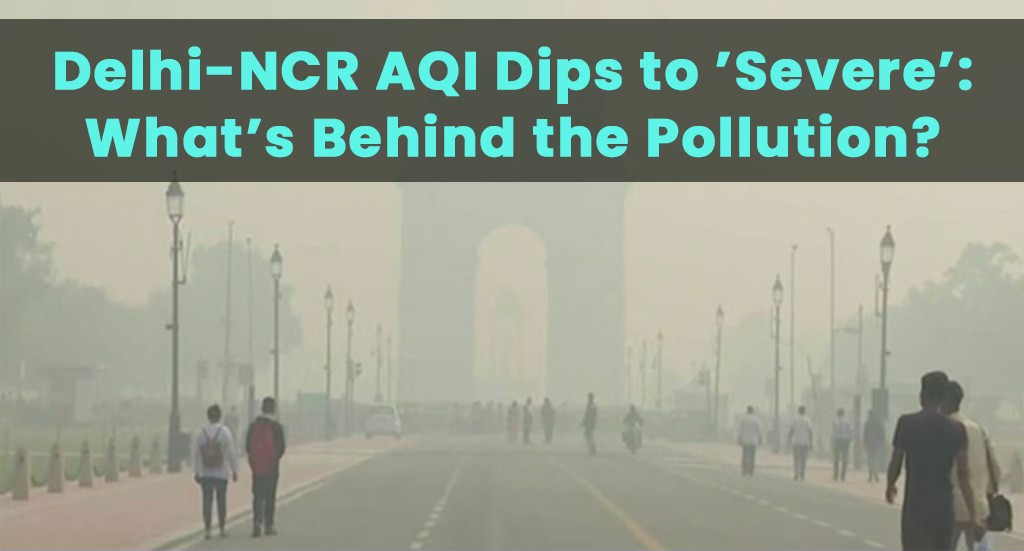Do you live in the national capital region? Have you felt the choking effect of the bad air? The capital is yet again enveloped in a thick layer of smog in multiple areas; the air quality continues to be classified as ‘severe.’ The Central Pollution Control Board (CPCB) reported an overall Air Quality Index (AQI) of 346.
The situation is alarming as hospitals in the Delhi-NCR area have observed an increase in instances of eye discomfort, persistent coughing, and throat infections as the air quality in the region deteriorated, reaching the ‘severe’ category in various locations. It is so bad that the buildings just a few metres away are not visible due to the smog.
The air quality in Delhi’s Lodhi Road, Jahangirpuri, RK Puram, and IGI Airport (T3) districts persists at a ‘severe’ level, with respective AQI values of 438, 491, 486, and 473. In an effort to enhance air quality, the Municipal Corporation of Delhi (MCD) is employing water sprinkling techniques in the Lodhi Road area.
The worst air quality was recorded in Delhi’s Anand Vihar at 999. Even the thought of this is uncomfortable and to live in such situations can be life threatening.
In these areas, the concentration of PM 2.5, a type of fine particulate matter that can deeply penetrate the respiratory system when inhaled, exceeded the safe limit of 60 micrograms per cubic meter by a factor of six to seven.
What’s Causing the Delhi Pollution?
Government agencies have warned that pollution levels in the Delhi-NCR region are expected to escalate in the next two weeks due to an increase in agricultural fires and unfavourable weather conditions like a drop in temperature and air speed. The Union Earth Sciences Ministry’s Decision Support System estimates that farm fires make up 13% of Delhi’s PM 2.5 levels, while the transport sector contributed 11.4%.
Health professionals have expressed concern, warning that the increase in air pollution could exacerbate respiratory and asthma issues, particularly among children and the elderly. The deteriorating pollution levels led to the decision to shut down schools for students in Classes 5 and below on both Friday and Saturday.
What Action is Being Taken?
On Thursday, a central pollution panel took action by prohibiting non-essential construction activities and the entry of diesel trucks into the capital city. These measures are in line with the Stage III Graded Action Response Plan, which was designed to address the yearly increase in pollution in the capital and its neighbouring regions.
This is an observation conducted by Delhi Pollution Control Committee that in the first two weeks of November the capital experiences the worst of pollution due to stubble burning in neighbouring states.
Furthermore, adverse meteorological conditions, along with emissions from firecrackers, burning of paddy straw, and local sources of pollution, all contribute to the dangerous air quality levels in Delhi-NCR during the winter season.
Delhi Chief Minister Arvind Kejriwal made an announcement on X platform, stating, “In light of the rising pollution levels, all govt and private primary schools in Delhi will remain closed for the next two days”.
In October 2023, Delhi recorded higher PM 2.5 levels compared to the same period a year ago, maintaining an upward trend that has been ongoing since 2021.
Between 2019 and 2020, the national capital experienced a significant 32% surge in PM 2.5 levels, followed by a notable decrease of 43.7% in 2021. Subsequently, there was a consistent rise in PM 2.5 levels in 2022 and 2023.
In light of the escalating pollution levels in the National Capital Region, doctors are advising individuals to refrain from early morning outdoor exercises or walks and are recommending the use of masks when heading out for work, shopping, or any other activities.
So, it’s time to mask up and brave this adverse weather till the smog clears up and follow each advice by the professionals to help calm this situation.








